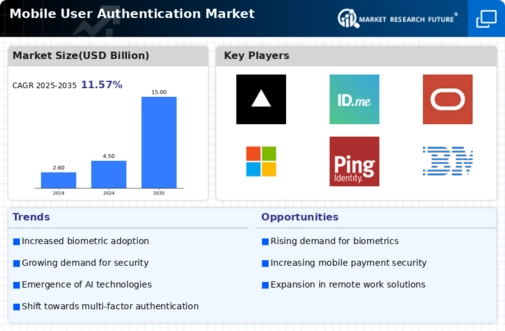Shift Towards Remote Work
The shift towards remote work has significantly influenced the Mobile User Authentication Market. As more employees work from home, organizations are compelled to adopt secure authentication methods to protect sensitive data accessed remotely. In 2025, it is anticipated that remote work will remain prevalent, with over 30 percent of the workforce operating outside traditional office environments. This trend necessitates the implementation of mobile user authentication solutions that can provide secure access to corporate resources from various locations. Consequently, the Mobile User Authentication Market is likely to see increased investment in technologies that facilitate secure remote access.
Increasing Cybersecurity Threats
The Mobile User Authentication Market is experiencing a surge in demand due to the increasing frequency and sophistication of cyber threats. As organizations face heightened risks from data breaches and identity theft, the need for robust authentication solutions becomes paramount. In 2025, it is estimated that cybercrime will cost businesses over 10 trillion dollars annually, prompting companies to invest heavily in mobile user authentication technologies. This trend indicates a shift towards multi-factor authentication and biometric solutions, which are perceived as more secure. Consequently, the Mobile User Authentication Market is likely to expand as businesses seek to protect sensitive information and maintain customer trust.
Emergence of Advanced Technologies
The emergence of advanced technologies such as artificial intelligence and machine learning is reshaping the Mobile User Authentication Market. These technologies enable the development of smarter authentication solutions that can adapt to user behavior and detect anomalies in real-time. In 2025, it is expected that AI-driven authentication methods will account for a significant portion of the market, as organizations seek to enhance security while minimizing user friction. This trend suggests that the Mobile User Authentication Market will continue to evolve, driven by innovations that improve both security and user experience.
Growing Adoption of Mobile Devices
The proliferation of mobile devices is a key driver for the Mobile User Authentication Market. With billions of smartphones and tablets in use, the demand for secure access to applications and services has never been higher. In 2025, it is projected that mobile device usage will surpass 80 percent of the global population, necessitating effective authentication methods. This trend is pushing organizations to implement mobile user authentication solutions that cater to a diverse range of devices and operating systems. As a result, the Mobile User Authentication Market is poised for growth, as businesses strive to enhance user experience while ensuring security.
Regulatory Pressures and Compliance
Regulatory pressures surrounding data protection and privacy are driving the Mobile User Authentication Market. Governments and regulatory bodies are implementing stringent guidelines to safeguard personal information, compelling organizations to adopt secure authentication practices. In 2025, compliance with regulations such as the General Data Protection Regulation (GDPR) and the California Consumer Privacy Act (CCPA) will remain critical for businesses. This regulatory landscape is likely to propel the demand for mobile user authentication solutions that ensure compliance while protecting user data. As a result, the Mobile User Authentication Market is expected to grow as organizations prioritize security and regulatory adherence.

























